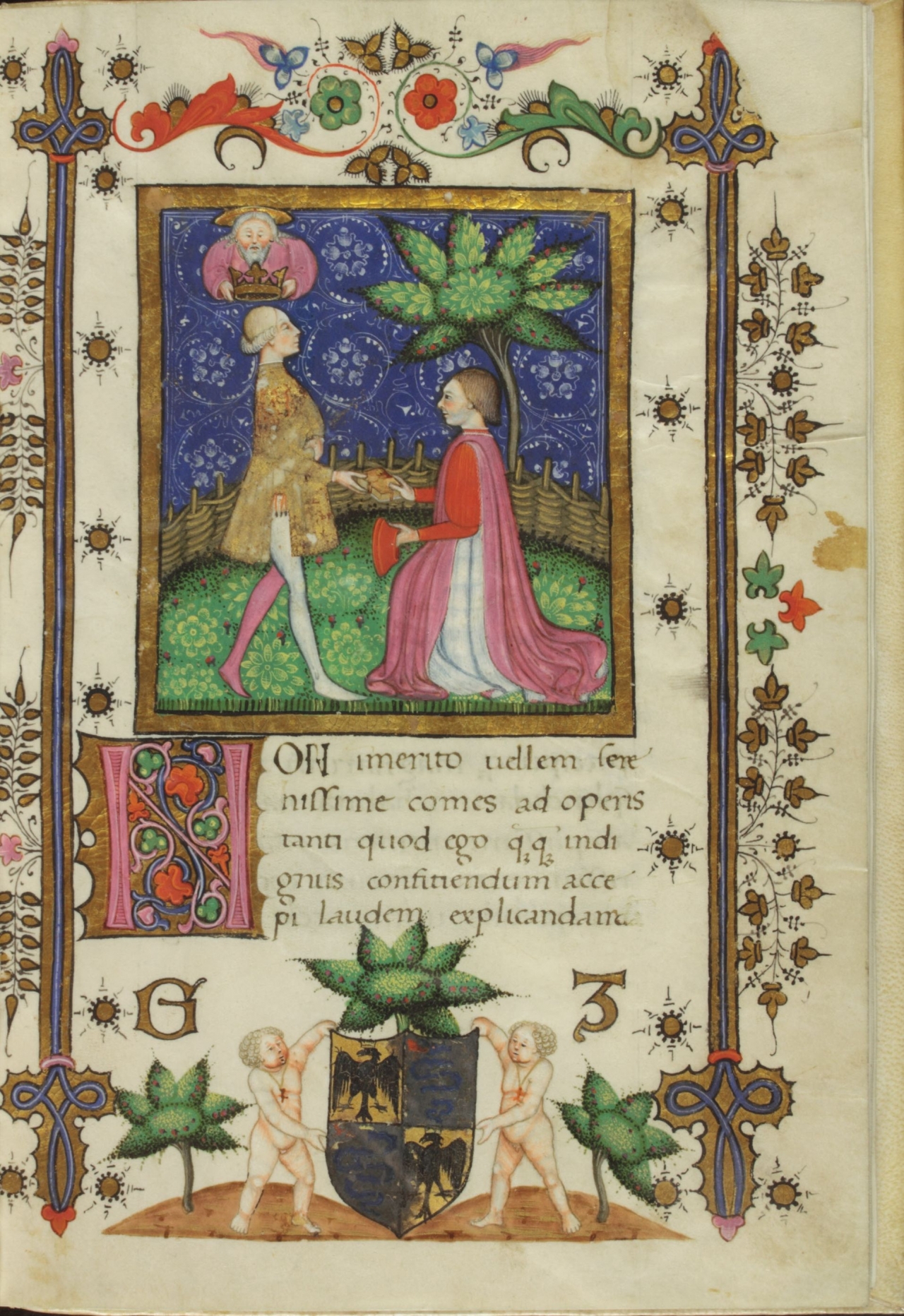Yes, I noticed. That's what got me excited. The "godfather" is specifically an old, bearded man with two angels below and a soul praying - as in the card (even if the angels don't have trumpets and the card has more than one soul below). Also, Time has an hourglass, which is of interest, since it isn't in the early Florentine ones, or 3943 (
https://digi.vatlib.it/view/MSS_Barb.lat.3943/0336, which has the solar figure as Time, supporting my idea that Time in the Modrone may have been the sun, as opposed to the old man, which would have come from Florence).
Added: another thing that occurs to me is that perhaps the orb held by the Colleoni/PMB Chariot-lady substitutes for the chain she holds in the miniature binding Cupid. It is the orb of dominion, more befitting her nobility than a chain. On the other hand, the orb is also in many Triumph of Fame illuminations.
It would be nice to know more about 3954, and not just its dating. In particular, where is it said that the artist is the same as for 3943? I don't doubt it, I just would like verification. It would help in dating both.
3943's Eternity (194r) also has the old man and the praying soul, but not the two floating angels. That motif (two angels lifting the soul of Laura on a cloth between them, without the old man) appears in another miniature, at 115v, whose main subject is Petrarch at Laura's grave, not part of the Trionfi illustrations.
Cohen in
Transformations of Time and Temporality says nothing about 3954; it doesn't even appear in her list of illuminated Petrarch manuscripts. About Vat.Barb.3943 (fols. 157r, 166v, 170v, 177r, 191r, 194r), she says (p. 326):
The manuscript is exceptional due to its brilliant areas of solid colors with gold highlights and decorative style that identify it as a Lombard work. The arms and initials of Giovanni Sforza, lord of Pesaro (1466–1510) must be a later addition to the manuscript. It is likely that the miniatures were executed in the 1460s, at the time Trivulziana cod. 1329 was illuminated for Galeazzo Maria Sforza (1444–76) in the same style (cf. fol. 1 of cod. 1329 in Bologna, 1973, 39). Arms of the Malatestiani precede the Rime of Malatesta de’ Malatesti (243r).
I would have thought earlier than the 1460s, because of the archaic Time as Apollo, or Petrarch's Sun. When the same motif occurs in another ms. (
https://digi.vatlib.it/view/MSS_Vat.lat.3157, "mid 15th c., N.E. Italy (Ferrara or Venice?)") , she says (p. 327)
The iconography of the Trionfo del Tempo (34r) is reminiscent of Trecento narratives, indicating that the artist was not in contact with contemporary mainstream illumination.
That ms., Vat.lat.3157, is of interest in other ways. Its Eternity has Christ in a mandorla, standing on an orb marked "Europe/Asia/Africa" and on either side souls in heaven on the left and those in hell on the right. So elements of both World and Judgment. That makes sense in a region where World is the final trump. Fame is just men in armor with their ladies. Death has a scythe, Pudicizia has the bound Cupid.
While the disc or orb of the world is associated with Eternity in this last ms., in others it is associated with Fame, a large circle behind her, symbolizing the world. This motif is very common, going back to at least 1380 (see the first two at
https://commons.wikimedia.org/wiki/Petr ... s_triumphs). It is described by Boccaccio in Amorosa Visione (IV.66): "a perfect circle/ rotating, lofty and round/ from beneath her feet and over her head." The lady is "the Glory of Worldly folk" (IV.75).
Of course this disc is behind Fame, not below her. But that occurs, too, in one where she also holds the scales (
https://commons.wikimedia.org/wiki/Petr ... orence.jpg).
It's nice to know that the Vatican has posted scans of so many Trionfi mss. Here are others.
https://digi.vatlib.it/view/MSS_Ott.lat.2998. Cohen says "bet. 1451–58, Neapolitan." The second through fifth triumphs show the previous one on the cart, vanquished below the triumphing figure, but not standing on it as in Robertet. Eternity has Christ in a mandorla above all the five previous ones lying lifeless on the ground.
https://digi.vatlib.it/view/MSS_Urb.lat.681. Cohen says, "between 1440–1460 (?), Florentine" and "probably done in the workshop of Francesco d'Antonio." Eternity, f. 187v, has an old bearded man in a mandorla formed by putti with very un-childlike faces. Time, 184v, is a stooped, winged old man with a cane. Fame, 177r, is winged with trumpets. Death, 167v, is bat-winged with scythe. Pudicizia, 163v, is winged, holding what seems like a torch, but is probably a branch, over the bound Cupid. All except Eternity have carts and wings.
https://digi.vatlib.it/view/MSS_Urb.lat.683. Cohen says,
Urb.lat. 683, between 1468 and 1485, Florentine. The codex contains illuminations of all six Trionfi (fols. 11r, 19v, 23r, 26r, 33r, 35v, 32v). The iconography is related to that of Pal. 72 (dated 1442) (supra no. 24) and other Florentine illuminations of the same group but is comparatively crude in style and was copied by a mediocre artist.
How she gets 1468 from a series that is like one in 1442 (one of the series attributed to Apollonio) she does not explain.
Cohen also lists a Vat. Barb. Lat. 3962, but no ms. with that name seems to be digitized.

